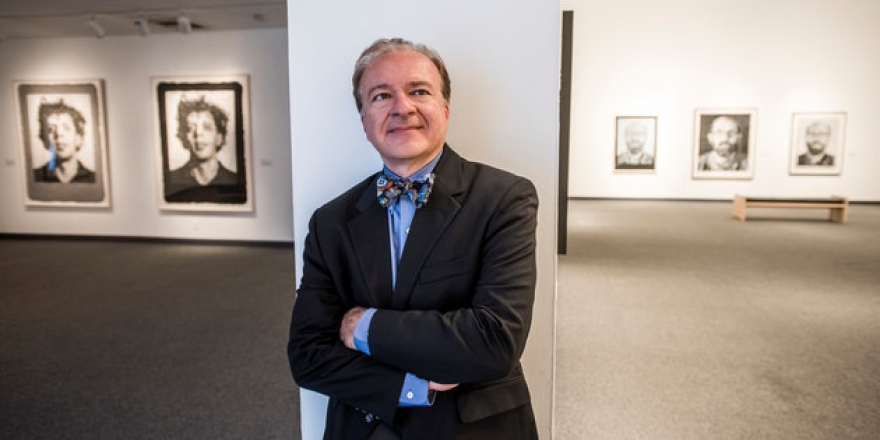Spiritual Abstraction
Few people would immediately associate religious painting with abstract art.
Earlier this year, Michael Zakian, director of the Frederick R. Weisman Museum of Art on Pepperdine’s Malibu campus, presented a lecture to students on spirituality and the origins of abstract art. He shared this highlight with Pepperdine Magazine.
But in the early years of the 20th century, a number of innovative artists understood and explored this connection. In fact, abstract painting was invented by artists who believed that art should provide a transcendent, religious message. They rejected the work of their predecessors—the 19th century realists—as being obsessed with concrete facts and physical matter. Traditional realism, in their eyes, was too materialistic, too concerned with the here-and-now. Instead of an art focused on the world, they envisioned a new type of painting that focused foremost on the spirit.
The artist usually credited with creating the first abstract, spiritual paintings is Vasily Kandinsky (1866-1944). Through a slow process of artistic experimentation, he produced his first abstractions between 1910 and 1914. Most people are surprised to learn that he came from a very traditional background and had little interest in art until relatively late in life. A native of Russia, he was raised in the Eastern Orthodox tradition and studied to be a lawyer at the University of Moscow. Upon completing his studies in 1893 he joined the law faculty there and was a highly regarded professor. A life-changing event occurred in 1895 when he visited Paris, France, and saw an exhibition of paintings by the French Impressionists. One work in particular, a painting of haystacks by Claude Monet, captured his eye and attention. The very next year, at the age of 30, he decided to abandon his career as a lawyer and university professor to pursue a new life as a painter.
Kandinsky moved to Munich, Germany—then a major art center second only to Paris. He met a number of other progressive painters, such as Paul Klee, and embarked on finding a new artistic expression fitting the energy, excitement, and promise of the 20th century. His early paintings from 1905 to 1908 were depictions of Russian fairy tales and folk stories. Painted in a simplified style resembling stained glass windows, these works captured a magical realm of knights and princesses, all rendered with intense, jewel-like color. But Kandinsky did not want to simply illustrate children’s stories; he had a greater goal. He wanted to capture the simple faith and sincere innocence that allowed people to believe in such stories.
As his paintings progressed over the next few years they became simpler. He eliminated many details, reducing his figures to basic large masses. He explored types of visual shorthand and began representing things through simple symbols: a triangle for a mountain, a cylinder for a tower. His figures became simpler and were rendered in forms that grew increasingly more spare and generalized. The “subject matter” of his folk tales became more obscure, but never disappeared. It was “hidden” and “masked,” requiring the attentive looking of a sympathetic soul to “see” the meaning residing within the images. Kandinsky was on the brink of creating the first abstract paintings.
It would take a bold step to eliminate the last residue of recognizable imagery. Kandinsky was obsessed about communicating with viewers and did not want to simply produce attractive lines and colors. He wanted to convey the power and force of the human spirit. One factor that assisted the development of his art was music. He was a musician himself and had long understood the power of music to move the human soul. In the 19th century, music was acknowledged to be the highest form of art because it was the most abstract and transcendent. Instrumental music does not imitate anything else. It consists purely of notes arranged in a rhythmic sequence. If Beethoven could produce powerful and moving compositions using only pure sounds, Kandinsky wondered, could it be possible to produce equally moving paintings utilizing only pure lines and pure colors?
Kandinsky believed that it was possible. In a work such as Sketch for “Deluge I” (1912), he effectively eliminated overt references to recognizable things. The painting exists as a sequence of rhythmic lines, shapes, and colors that vary in mood from the playful and lyric to the powerful and profound. As in most of his earliest pure abstractions, there are still references to hidden symbols. If you look closely, you can see a white, jagged line to the right of center that resembles a lightning bolt. To the left of that is a large triangular shape that stands for a volcano erupting. More obscure are a number of small figures representing people attempting to escape the flood. Kandinsky wanted to capture the apocalyptic feeling of the biblical flood—anticipating the wave of human destruction that was World War I.
In later versions of the Deluge theme, Kandinsky did away with all recognizable symbols. He wanted to convey his passionate message through pure visual means, creating an emotional arrangement of lines, shapes, and colors. Like a parable, his abstract paintings are not descriptive or didactic. They have to be interpreted by a sympathetic soul.
